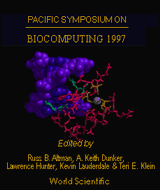The native sequence determines sidechain packing in a protein, but does optimal sidechain packing determine the native sequence?
Koehl P, Delarue M
UPR 9003 du CNRS, Graffenstaden, France.
Pac Symp Biocomput. 1997;:198-209.

Abstract
Globular proteins have highly compact structures and the corresponding packing interactions are widely considered as the principal determinant of the native structure. It is therefore important that theoretical approaches to protein design explicitly take in account packing, which requires that a full atomic representation of the designed protein is maintained. As a first step towards this goal, we have developed in this report an inverse folding algorithm with the aim of specifically designing amino acid sequences which optimise sidechain packing for a given protein fold. The design is performed by a global Monte Carlo optimisation in sequence space, with constant amino acid composition and a full-atom representation of the various protein models. Packing is defined by a Lennard-Jones potential. The program was tested by designing stable sequence variants for the chymotrypsin inhibitor fold. The final protein models showed an increase in intramolecular atomic contacts and a decrease in the overall volume compared to the native structure. Starting from the backbone only of the target structure, the algorithm did gradually retrieve reliable though limited sequence information. Higher compatibility might be achieved by improving the potential, however our results suggest that packing interactions are an essential element of a yet-to-be-defined successful energy function for protein design.
[Full-Text PDF] [PSB Home Page]